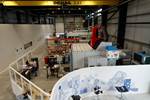C-Scan inspection facility cuts cost for commercial copter
Bell Helicopter Textron’s (Ft. Worth, Texas) 429 helicopter, first revealed in 2008, is targeted to individual, corporate and emergency-services customers.
Bell Helicopter Textron’s (Ft. Worth, Texas) 429 helicopter, first revealed in 2008, is targeted to individual, corporate and emergency-services customers. Fabricated at Bell’s Mirabel, Quebec, Canada facility, each of the aircraft’s carbon fiber/epoxy airframe parts is tested by Talon Test Laboratories Inc. (Indianapolis, Ind.) using ultrasonic nondestructive testing (NDT) methods. Talon was selected because its 60,000 ft² (5,575m²) lab houses a new, large-scale NDT machine that can accommodate the 429’s approximately 12-ft long by 7-ft tall (3.7m by 2.2m) fuselage sections, says Anthony Tokarz, Talon’s national accounts manager.
The 12-axis C-Scan system was manufactured by Talon’s sister company, Structural Diagnostics Inc. (SDI, Camarillo, Calif.), in a “tower” rather than a gantry configuration, explains Tokarz. The machine’s 17-ft/5.2m tall tower frame moves side to side on floor rails, supporting the automated C-Scan “through-transmission” heads, which are capable of multiple axes of motion over the system’s entire 19-ft by 8-ft (5.9m by 2.5m) work envelope. During scans, each component is supported by an ancillary framework that fits within the envelope. The C-Scan head’s water-squirter transmitter emits a pulsed sound wave above the range of human hearing (from 1 to 10 MHz, depending on the material). A matching transducer focused on the part’s backside captures the sound waves that travel through the part, detecting structural flaws by reading differences in wavelength data. The water acts as a coupling agent because high-frequency sound waves tend to attenuate in air. (The water is captured and recycled.) Advanced motion control enables precise head movement while dual motorized gimbals enable the heads to conform to part contours.
According to Tokarz, Talon can maintain a tight tolerance (better than ±1 dB) over the entire scanning envelope. The unique tower design reportedly allows quicker scans for faster turnaround. Because parts were previously shipped from Mirabel to Ft. Worth for testing, the Talon contract cuts shipping costs and time by two-thirds.
Related Content
-
Damage tolerance testing of sandwich composites: The sandwich CAI test
A new ASTM-standardized test method established in 2022 assesses the compression-loaded damage tolerance of sandwich composites.
-
Numerical tool with mean stress correction demonstrated for fatigue life estimation of thermoplastic composites
To aid design of fatigue-resistant structures, Econ Engineering has developed an algorithm to evaluate ply-based cyclic stiffness degradation combined with an FE failure check, validated for a CF/PAEK pressure vessel.
-
Proving thermoplastic composites match carbon fiber/epoxy performance in road bikes
CDCQ, LxSim, Addcomp and Argon 18 collaborate to optimize a carbon fiber/PA6 bike seat post, democratizing AFP and demonstrating materials and process for future designs and production.



